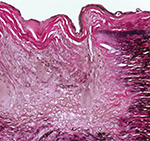An examination of a claims reimbursement database demonstrated an association between incident giant cell arteritis and recent prescriptions for a fluoroquinolone (OR 2.21, 95% CI 1.12–4.09).
These results support the results of an older study, which observed that the incidence of giant cell arteritis is subject to periodic peaks, just like an epidemic infection.3 However, attempts at identifying a specific culprit agent have failed to yield a promising candidate. Possibly, this may imply that giant cell arteritis can be caused by multiple, unrelated pathogens that induce the same immune response.
The observation linking the onset of giant cell arteritis with prescriptions for fluoroquinolones is a new piece of the puzzle. However, because fluoroquinolones are used for a broad range of indications, the number of potential pathogens remains vast.
3. FDG-PET in patients with giant cell arteritis on tocilizumab. Kaitlin Quinn, Mark Ahlman, Peter Grayson. Abstract O-096.
Tocilizumab has rapidly become part of the standard of care for the treatment of giant cell arteritis. However, tocilizumab also suppresses the acute phase reactants (e.g., erythrocyte sedimentation rate, C-reactive protein) used to track disease activity, further complicating the management of patients with giant cell arteritis treated with tocilizumab.
Quinn et al. identified 31 patients with giant cell arteritis who had achieved clinical disease remission following treatment with tocilizumab for at least six months. Fluorodeoxyglucosepositron emission tomography (FDG-PET) was performed after a median disease duration of 1,070 days, following treatment with tocilizumab for a median of 254 days (interquartile range 189–558).
FDG-PET demonstrated disease activity in 55% of patients. However, none of these patients demonstrated angiographic progression of their vasculitis. Five of the 17 patients who had stopped tocilizumab experienced a disease relapse a median of 1.3 years following drug discontinuation. However, FDG-PET did not demonstrate disease activity in two of these five patients.
Recently updated recommendations from EULAR suggest using imaging studies, such as FDG-PET, to assess for disease activity among patients with giant cell arteritis treated with tocilizumab.4 Notably, Quinn et al. used an FDG-PET scanning protocol optimized for detecting vascular inflammation, including prolonged signal acquisition times, which is not yet standard in most facilities. Despite this, they were unable to demonstrate that FDG-PET was useful for predicting either disease progression or relapse in this patient population.
4. Gastrointestinal perforation in patients with giant cell arteritis on tocilizumab. Desh Nepal, Sebastian Sattui, Zachary Wallace, Michael Putman. Abstract P-055.
Gastrointestinal perforation has been associated with tocilizumab, particularly among patients with a history of diverticulitis. Because diverticular disease is common in an elderly population, many clinicians hesitate to use tocilizumab for patients diagnosed with giant cell arteritis.

